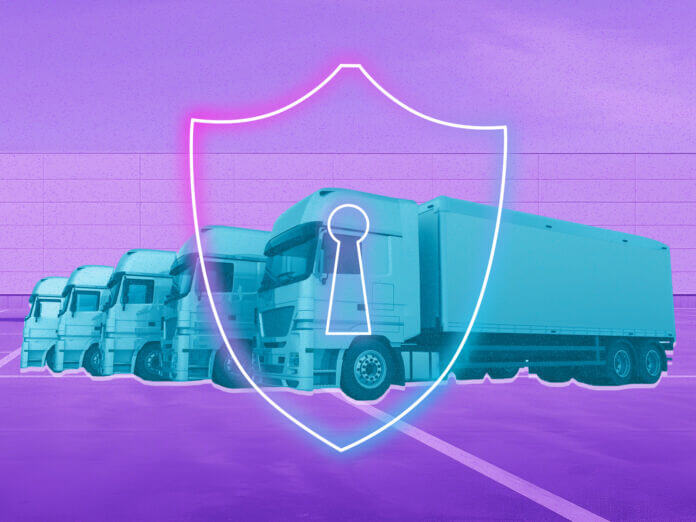
Zac Amos – October 7, 2024
Collected at: https://www.iotforall.com/essential-cybersecurity-practices-for-iot-based-fleet-management
IoT-integrated technologies have created a seamless way for businesses to manage their fleets. However, the Internet of Things comes with cybersecurity threats. The more connectivity there is, the higher the risk. Therefore, fleet management teams need to understand these technologies’ vulnerabilities and the best cybersecurity practices to prevent them.
The Growing Need for IoT Security in Fleet Management
IoT has become essential to industries that require a fleet of vehicles. In fleet management, IoT solutions continuously collect data to help companies track their vehicles in real-time and plan the most efficient routes. This technology also allows them to perform diagnostics remotely, ensuring the safety and reliability of their operations. This technological solution makes it a highly valuable asset for maximizing fleet use while minimizing operational costs.
The market for IoT-based fleet management is growing. It was valued at $8.5 billion in 2023, and now market researchers estimate it will increase by 11% between 2024 and 2032. This growth is good news for IoT manufacturers, but the increased adoption also comes with a rising cybersecurity concern.
Cyberattacks on IoT-based systems are increasing at an alarming rate. In 2022, there were over 112 million IoT breaches, a major jump from the 32 million reported four years earlier. With an upward trend in IoT security vulnerabilities, fleet management must address cybersecurity threats before they lead to operations disruptions and financial losses.
Small businesses are especially vulnerable to cyber threats. According to research, approximately 43% of cyberattacks target startups. These companies are often short on resources to implement strong cybersecurity measures, making them an attractive target for hackers. For fleet managers relying on IoT devices to track and monitor their vehicles, ensuring strong security protocols is key to protecting their businesses and clients.
Key Cybersecurity Issues With IoT and Fleet Management Systems
As IoT integration grows into fleet management, it introduces several vulnerabilities that can compromise the system’s security and the fleet’s safety. Understanding these top security issues is the first step toward protecting IoT-based fleet management systems.
Data Breaches and Unauthorized Access
Since fleet management systems rely on IoT devices to collect sensitive information, companies are at a larger risk of data exposure. IoT devices are most vulnerable to cyberattacks because they often lack data encryption.
This makes it easy for hackers to gain access to the various entry points these connected devices provide. With the vast data these technologies gather, a single breach could allow hackers to intercept the information that transfers between devices and the system.
GPS Spoofing and Jamming
When hackers gain access to the fleet management systems, they can gain complete control over the vehicles. Cyberattackers can mess with the GPS signals and cause drivers to take inconvenient routes. Additionally, manipulating the GPS signals can block vehicle location and communication. These levels of attacks can be a serious disruption to a company’s operation and result in financial loss.
Best Practices for Securing IoT-Based Fleet Management Systems
Fleet management can bolster their IoT systems’ and personnel’s safety and security by following several best practices.
1. Perform a Risk Analysis
Risk analysis is key to understanding the stakes involved and what strategy fleet managers can take to implement effective IoT security measures. Take this step by assessing the system for vulnerabilities and the likelihood of attacks. Evaluating these factors allows management to focus on areas that pose the greatest risk and prioritize their security efforts.
2. Use End-to-End Encryption
Data encryption is a foundational step in securing the information transmitted between IoT devices and fleet management systems. These security solutions ensure the data is safe from the point it leaves a device until it reaches its intended destination.
The benefit of using end-to-end encryption is that the data is nearly impossible for unauthorized parties to breach and decipher. Whether it is vehicle diagnostics, location data or driver behavior reports, software encryption will protect this sensitive information as it travels across networks.
3. Implement Device Authentication and Access Controls
Ensuring only authorized devices and users can access the fleet management system is a fundamental security measure. Start by implementing strong device authentication protocols, such as multi-factor authentication. Doing so will prevent anyone unauthorized from accessing the network.
Additionally, customizing access controls is crucial. This step enhances security by restricting permissions based on user roles, ensuring that only those who need access to specific data or system functions can use them. These measures create another layer of protection, reducing the risk of compromised devices and insider threats.
4. Schedule Regular Software Updates
All IoT devices and fleet management software require updates to maintain security. Cybercriminals often exploit these areas of opportunity, as outdated software and firmware increase vulnerabilities. That is why scheduling regular software updates and patches is critical. These updates will fix security gaps and improve overall system performance.
Automating updates where possible can ensure all technologies are running the latest versions, reducing the risk of cyberattacks.
5. Network Segmentation
Isolating IoT devices from the corporate network is a key strategy for limiting the impact of cyberattacks. Fleet management can achieve this by dividing the network into smaller segments. This action can contain breaches to one part of the system without compromising the entire network.
Therefore, if one segment has a breach, the attacker cannot access sensitive data affecting the rest of the business’s operations. Multiple layers enhance the system’s security, minimizing the risk of widespread damage.
Prioritizing IoT Security for Safer Fleet Management
IoT is growing in fleet management, making the implementation of security measures crucial. Consider creating a framework of the best security measures to practice to ensure the fleets remain operational. When teams are proactive in protecting their company’s data, they can sustain more success and safety in the long run.

Leave a Reply